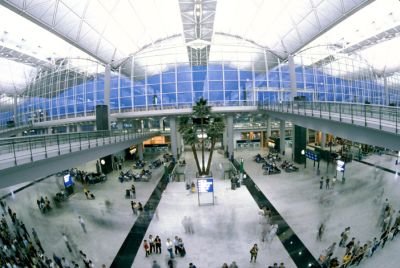Hong Kong International Airport is the main airport in Hong Kong. It is also known as Chek Lap Kok Airport, due to the fact that it was built on the island of Chek Lap Kok by land reclamation. Hong Kong is based on an island and there is a severe shortage of land near Hong Kong. So, a mega-project was undertaken to reclaim the ocean to build a world-class international airport.
The airport opened for commercial operations in 1998, replacing Kai Tak Airport, and is an important regional trans-shipment centre, passenger hub and gateway for destinations in China, East Asia and Southeast Asia. The old airport was insufficient for the growing needs of Hong Kong and hence had to be shut down. The new Chek Lap Kok airport can easily handle a lot more volume of passengers and goods.
The Old Hong Kong International Airport
The old airport was located in a densely populated area, and had become quite frustrating and dangerous for pilots. Landing on that airport required considerable expertise, and was a serious risk for large aircraft. The old airport had also become inadequate to handle ever-increasing traffic and goods, as well as new-generation aircraft. Hence, it was closed down in 1998, after the completion of the new Airport.
http://www.youtube.com/watch?v=3PCOcyt7BPI
Construction of Airport
On July 6, 1998, Hong Kong opened its new International Airport 16 miles out at sea, But First, Engineers had to build not only the largest passenger terminal on Earth, but a whole new island to hold the airport, the miles of tunnels, bridges and roadways to connect it to the mainland.]
The construction of Hong Kong International Airport at Chek Lap Kok was one of the biggest operations in the industry. The core programme cost more than $20bn and involved four major sponsors, ten separate projects, 225 construction contracts and over 1,000 critical interfaces.
The airport covers 12.48km² of reclaimed land between the two islands of Chek Lap Kok and Lam Chau. The airport increased the land area of Hong Kong by 1%. The airport opened for business in July 1998 taking six years to build.
Terminal Building
The passenger terminal claims to be the world’s largest enclosed space with 70 moving walkways stretching more than 2 miles, a pilotless electric train, 150 shops and a 1100-room hotel.
The flat-island housing Hong Kong International Airport was actually two mountainous islands when the construction began. But the mountains were pulverised and their rocks recycled to fill 1.5 miles if sea now connecting Chek Lap Kok and Lam Chau.
Access to Airport

A new transportation corridor stretches 34km from Hong Kong Island to the site of the airport, incorporating a high-speed rail system, two tunnels, two bridges and a six-lane expressway. It contains the world’s longest double-decker suspension bridge.
Designed for the rapid movement of millions of passengers, the airport has 288 check-in counters, 200 immigration desks and 80 customs positions. The new airport also boasts 2.5km of moving walkways and around 120 shops.
Lantau Link
The 1.3-mile long Tsing Ma Bridge is teh world’s longest span suspension bridge, linking cars and railway traffic between Lantau Island and the rest of Hong Kong. Part of the comprehensive transportation network, its concrete towers rise nearly 700 feet. It is the world’s seventh longest span suspension bridge. It has two decks and carries both road and rail traffic, which also makes it the largest suspension bridge of this type. The bridge has a main span of 1,377 metres (4,518 ft) and a height of 206 metres (676 ft). The span is the largest of all bridges in the world carrying rail traffic.
The 41 metres (135 ft) wide bridge deck carries six lanes of automobile traffic, with three lanes in each direction. The lower level contains two rail tracks. There are also two sheltered carriageways on the lower deck for maintenance access and as backup for traffic when particularly severe typhoons strike Hong Kong. Though road traffic would need to be closed in that case, trains could still get through in either direction.
Facilities at Airport

The shopping and leisure facilities include the airport’s SkyMart with 160 shopping outlets and 40 restaurants spread over 39,000m². The facilities also include free and pay internet lounges, Wi-Fi access, many lounges and TV screens and a children’s play area. The superior facilities have meant that the airport has been voted the world’s best in 2002, 2003, 2004 and 2005 (came first in Skytrax’s world airport awards in 2007) and is consistently in the top-five list.